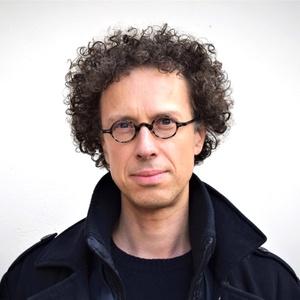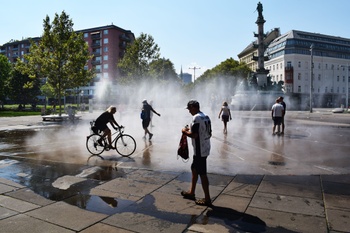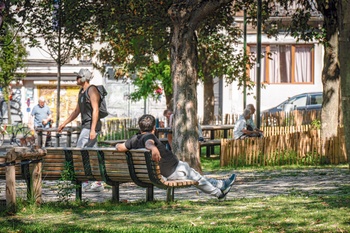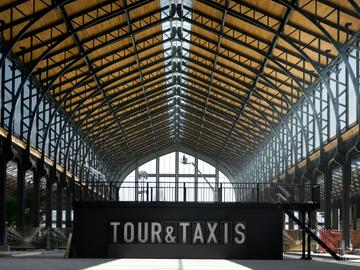More extreme rain and above all, heat. We know what the future holds, but the Brussels response could be quicker. In Copenhagen and Vienna, we saw how to adjust the city to the rapidly changing climate.
© Kris Hendrickx/BRUZZ
| Islands Brygge Havnebadet, het oudste openluchtzwembad van Kopenhagen.
Do you know many residential streets where a lot of trees have been planted in recent years? Do you know where to cool off when it's 35 degrees inside? And did you know that the Brussels sewer system overflows into the Zenne no less than eighty times a year when it rains, causing plastic pollution and fish mortality? The answer is probably three times 'no'. Brussels is therefore not a pioneering city when it comes to adapting to a rapidly changing climate.
"Anyone who wants to create a cooler and rainstorm-resistant city should invest massively in street greenery, preferably nourished by rainwater"

Yet there is a great need. Not only was it obvious this month, during the first ever September heatwave. But the figures tell the same story. Today, people living in the city centre already experience two to three times as many heatwave days as people living outside the city. Recuperating at night is then out of the question, as temperatures will be up to ten degrees higher than in the surrounding countryside. And it won't stop there. Studies expect the number of heatwaves to triple in the heart of the city over the next century.
Human lives
These extra degrees are not harmless. They cost more and more human lives, weigh on biodiversity and on the urban economy. Poorer city-dwellers also feel the heat load extra hard. They are more likely to live in neighbourhoods that are literally hotter and cannot easily escape to holiday homes. Rising urban temperatures are then a pressing social issue.
A bit depressing? Maybe, but there is hope. All over the world today, cities are on the lookout for recipes to reduce their climate footprint, but also for ways to adapt to the consequences of a climate change which we will no longer be able to stop. Sometimes hesitantly, sometimes resolutely looking to the future, BRUZZ visited two cities from the latter category: Copenhagen and Vienna.

© Kris Hendrickx/BRUZZ
| The Praterstern traffic junction in Vienna was de-paved, adding many trees, and the city also created a popular water playground with over 300 sprayers
The Danish capital - after an unprecedented flood in 2011 - is preparing itself especially against heavy rain. The administration is trying to collect rainwater in all possible places and to slow it down via new green zones in the city, which simultaneously buffer water, if necessary, as floodable parks. The fascination around the Copenhagen approach lies in its versatility: these green solutions not only hold back the rain, they also reduce CO2 emissions, provide recreational spaces for city dwellers, enhance urban nature and cool down the environment. Another advantage: the more rainwater is held back, the more likely you are to be able to swim in the harbour. We did it every day.
Lying awake
Vienna, meanwhile, lies awake at night worrying about the growing heat stress. You can take that 'lying awake' quite literally: during our stay, the temperature in the city centre did not drop below 30°C at night for days on end. Our days in the Austrian capital felt like a trip into the future. Faced with this urban 'heat island' effect, Vienna is proposing a whole range of measures. The most important, and most banal, is to plant many more trees in the city. But you will also read further on about micro cool oases, about the city as a big sponge, and how we can also use the wind as a big fan.

© Bart Dewaele
| At many places, new - often small - green zones have been added in recent years, such as here in the Marie Janson Park in Saint-Gilles.
And Brussels? It would be unfair to say that nothing is happening here. New, often small, green zones have been created in quite a few places in recent years. Some of them, such as the Marie Janson Park in Sint-Gillis, are already designed with climate adaptation in mind. At the same time, we did notice that things are still moving slowly. If you really want to make the city cooler and more resilient to storms, you must invest heavily in street greening, preferably rain-fed. Today, this is only happening sporadically. And even when it comes to cool indoor spaces - at home or in public places - we are not very far advanced. Why is that? The administrative lasagna in Brussels is certainly not making things any easier.
In the meantime, let this issue be a call to shift up a few gears for the sake of all users of the city and the most vulnerable in particular.
More? Watch the TV report at BRUZZ.be/klimaatstad and listen to BRUZZ radio on Wednesday, Thursday and Friday at 12.10 pm.
Klimaatbestendige stad
Read more about: Brussel , Opinie , Klimaatbestendige stad , klimaatverandering , opwarming van de aarde , leefbaarheid , levenskwaliteit




Fijn dat je wil reageren. Wie reageert, gaat akkoord met onze huisregels. Hoe reageren via Disqus? Een woordje uitleg.